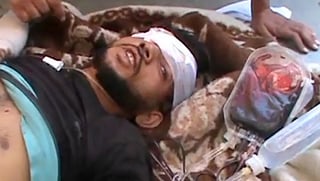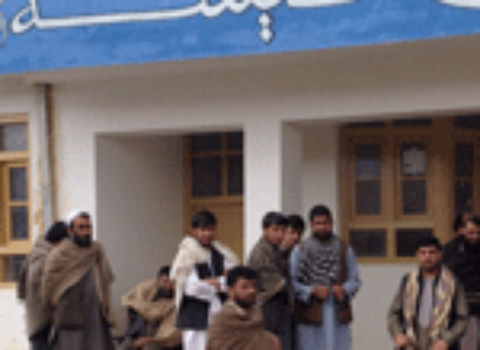Anand Gopal writes frequently about the Middle East and South Asia. He is the author of “Welcome to Free Syria,” in the August 2012 issue of Harper’s Magazine. His book about the war in Afghanistan is forthcoming from Henry Holt.

Last month, video emerged from the Syrian town of Tremseh showing scores of blood-sodden bodies of children and adults, some with cracked skulls and slit throats, all of them purported victims of the Syrian army. As the camera panned across the grisly tableau, an anguished commentator read out the names of the dead and cried, “God is greater!” The Syrian National Council, an umbrella rebel group, announced that 305 people had been killed, making Tremseh the gravest massacre of the fifteen-month-long uprising. Hillary Clinton decried this “indisputable evidence that the regime murdered innocent civilians,” and the United Nations issued its strongest condemnation of Syria to date.
But there was a problem—no one had actually visited the town. The New York Times, for instance, reported the story from Beirut and New York, relying solely on statements and video from anti-Assad activists and the testimony of a man from “a nearby village” who visited the scene afterward. When the first U.N. investigators arrived two days later, they uncovered a very different story. Instead of an unprovoked massacre of civilians, the evidence pointed to a pitched battle between resistance forces and the Syrian army. Despite rebel claims that there had been no opposition fighters in Tremseh, it turned out that guerrillas had bivouacked in the town, and that most of the dead were in fact rebels. Observers also downgraded the death toll to anywhere from forty to a hundred.
The battles of the Syrian revolution are, among other things, battles of narrative. As I recount in “Welcome to Free Syria,” the regime has indeed committed grievous massacres, including one I saw evidence of in the northern town of Taftanaz. The Assad government also puts forth a narrative—the country is under siege from an alliance of criminal gangs, Al Qaeda, and the CIA—that is quite removed from reality. Yet there is also a powerful pull in the West to order a messy reality into a simple and self-serving narrative. The media, which largely favors the revolution, has at times uncritically accepted rebel statements and videos—which themselves often originate from groups based outside the country—as the whole story. This in turn provides an incentive for revolutionaries to exaggerate. A Damascus-based activist told me that he had inflated casualty numbers to foreign media during the initial protests last year in Daraa, because “otherwise, no one would care about us.”
Some in the West are equally uncritical in their skepticism toward the revolutionaries. Mike Rogers (R., Mich.), chairman of the House Intelligence Committee, recently declared that as many as a quarter of Syrian rebel groups may be inspired by Al Qaeda—which, according to those who have been inside and met the resistance, is simply not the case. Al Qaeda–style groups can be found among the revolutionaries, but they remain rare. Moreover, radical Islam is far more complex than Washington tends to appreciate. I’ve met beer-guzzling Syrian rebels who carried the black Al Qaeda flag, but for whom this was no contradiction: Islamist stylings in Syria are typically part performance vocabulary, part unifying norm in a riven society, part symbolic invocation of guerrilla struggle in a post–Iraq War world, and part expression of pure faith.
How do we pick through the signaling? There’s still no substitute for on-the-ground reporting (another recent New York Times article that was reported entirely outside Syria sounded alarm at Al Qaeda taking “a deadly new role in the conflict”). But we also need to examine our epistemic framework for the revolution. Syrians are fighting for complex reasons that often do not conform to the way Western leaders have ordered their knowledge of the world: “moderate” versus “extremist” or Western-style democracy versus dictatorship. As my feature illustrates, some of the revolutionaries have established councils that look unlike our institutions, but that are deeply democratic in their own way. Others adore Western-style social liberalism but scoff at the West’s free-market ethos. Others seek some variety of religious law. And most probably don’t know yet what they want, except to live in dignity, free from political and economic repression.
But the complexity doesn’t end there, because, as I realized during my visit, the revolutionaries themselves face a powerful need to order facts in certain ways. The rebels I met in Idlib Governorate spoke of every defeat they suffered as a tactical retreat. Or they insisted that their uprising was supported by all minorities, even as it was becoming unmistakably sectarian. Such claims are designed in part, to be sure, for foreign consumption, but they also serve the rebels themselves. They create value and meaning in what might otherwise be a state of anomie, cohering people around a just and fruitful cause even as families are slaughtered and the regime stands unbroken. Following a devastating series of defeats in northern Syria this spring, I asked a rebel commander there whether he thought Assad would ever fall. “Of course,” he replied. “I know we will win—otherwise, why would we still fight?”




